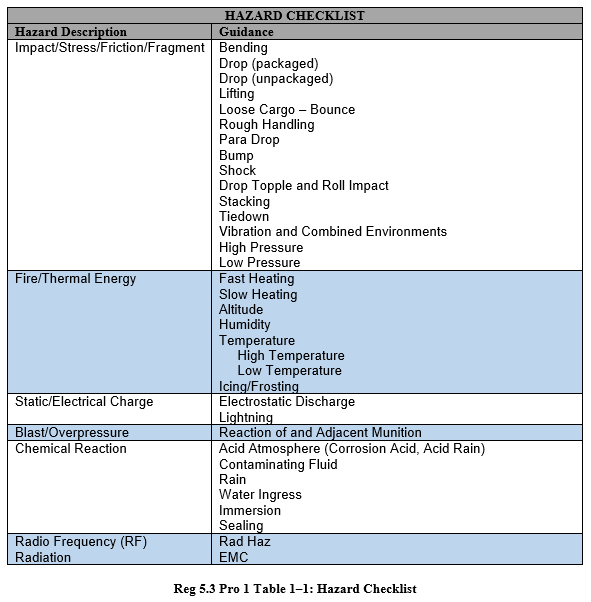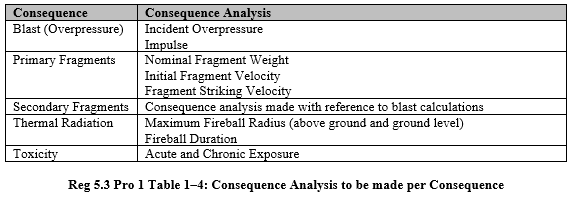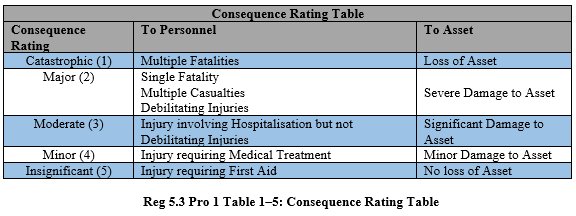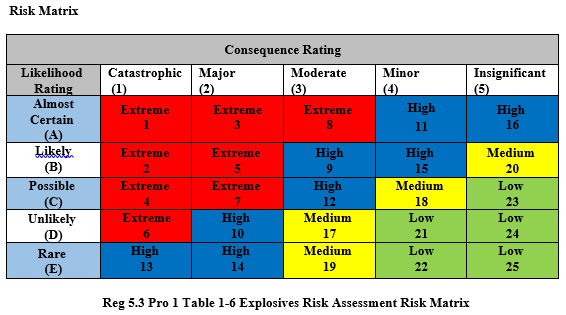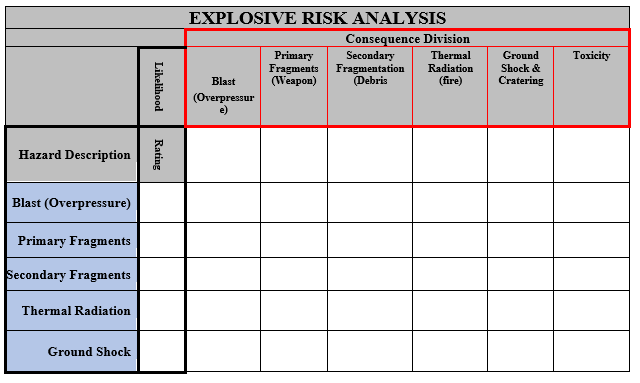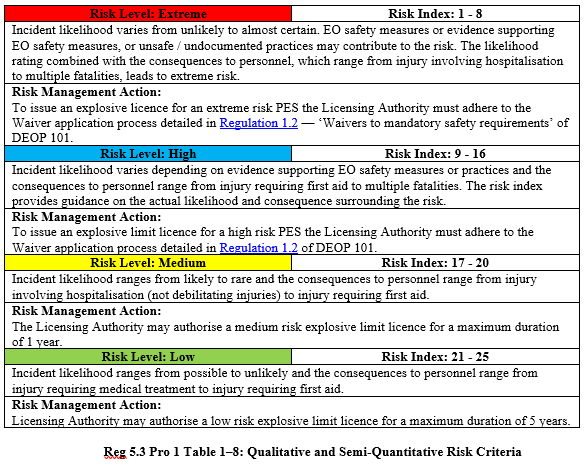Title Page
-
Conducted on
-
Prepared by
-
Location
-
ERA Detaills
LARGE QUANTITY FACILITY (LQF) EXPLOSIVE RISK ASSESSMENT (ERA)
-
General Information
-
Explosion Effect by Hazard Division
Based on the list of EO provided by the applicant select the Hazard Division of EO to be stored or processed within the PES to determine the applicable explosion effects to be considered. Delete inappropriate descriptions below. -
HD 1.1
HD1.1 comprises substances and articles that have a mass explosion hazard. The major hazards of this division are blast, high velocity projections and other projections of low velocity. An explosion may result in severe structural damage. The severity and range being determined by the amount of explosives involved, and the distance from the explosion site. There may be a risk from heavy debris propelled from the structure in which the explosion occurs, or from the crater. HD1.1 may display hazards associated with other HD. -
HD 1.2
HD1.2.1 is comprised of explosive articles that have a projection hazard, but not a mass explosion hazard. An explosion results in burning and exploding progressively, a few at a time. Furthermore, fragments, firebrands and unexploded items may be projected in considerable numbers; some of these may explode on impact and cause fires or explosions. Blast effects are limited to the immediate vicinity. HD1.2.1 contains the more hazardous items of HD1.1, which give large fragments over an extended range These articles have an individual NEQ of 0.71 Kg or above. -
HD1.2.2 is comprised of explosive articles that have a projection hazard, but not a mass explosion hazard. An explosion results in burning and exploding progressively, a few at a time. Furthermore, fragments, firebrands and unexploded items may be projected in considerable numbers; some of these may explode on impact and cause fires or explosions. Blast effects are limited to the immediate vicinity. HD1.2.2 contains the less hazardous items of HD1.2, which give smaller fragments of limited range. These articles have an individual NEQ of below 0.71 Kg.
-
HD 1.3
HD1.3.3 comprises substances and articles that have a fire hazard and either a minor blast hazard or a minor projection hazard or both, but not a mass explosion hazard. HD1.3.3 includes some items that burn with great violence, and intense heat, emitting considerable thermal radiation (mass fire hazard) and others that burn sporadically. Items in this division may explode but do not usually form dangerous high velocity fragments. However, firebrands and burning containers may be projected. HD1.3.3 contains the more hazardous items with mass fire hazard and considerable thermal radiation. These articles generally correspond to Compatibility Group C, such as propellant and bulk stocks of pyrotechnic substances. -
HD1.3.4 comprises substances and articles that have a fire hazard and either a minor blast hazard or a minor projection hazard or both, but not a mass explosion hazard. HD1.3.4 includes some items that burn with great violence, and intense heat, emitting considerable thermal radiation (mass fire hazard) and others that burn sporadically. Items in this division may explode but do not usually form dangerous high velocity fragments. However, firebrands and burning containers may be projected. HD1.343 contains the less hazardous items that burn sporadically.
These articles generally correspond to Compatibility Group G (but include Groups H, J, K and L). -
HD1.4 is comprised of articles that present no significant hazard. HD1.4 includes items that primarily pose a moderate fire hazard. They do not contribute excessively to a fire. The effects are largely confined to the package unless the package becomes degraded due to the effects of a fire. No fragment of appreciable size or range are to be expected. An external fire does not cause the simultaneous explosion of the total contents of a package of such items. Some, but not all items of HD1.4 are in the Compatibility Group S. These items are designed or packaged such that any hazardous effects arising from the accidental functioning are confined within the package unless the has been degraded by fire. In this case all blast or projection effects are limited to the extent that they do not significantly hinder fire fighting or other emergency response efforts in the immediate vicinity, ie. Within 5m of the packages.
Site Details
-
a. Site Name:
-
b. Potential Explosion Site Identification Number or Name:
-
d. The Hazard Division/s (HD) of all EO stored in the facility
List type of EO to be normally stored or processed in the PES. Complete for each PES under consideration.
-
Seril / Item Name / Qty / Total Neq / HCC / Type of Packaging
List all Exposed Sites (ES), including other EO facilities, within the vicinity of the PES. Complete a separate list for each PES under consideration.
-
PES
-
ES / Facility Function / Construction Types / No of Occupants / Daily period of Occupation / Facility Vital (Y/N) / Distance from PES (Metres)
Risk Assement Details
-
e. Any assumptions made prior to the risk assessment being undertaken. Assumptions must be stated to ensure the Licensing Authority or higher authority is aware of the circumstances and limitations of the assessment.
-
f. Construction details of the facility where EO will be stored.
-
g. Potential Explosion Site (PES) and Exposed Site (ES) details.
-
h. Valuable asset details.
Hazard Identification and Likelihood Rating
-
Identify and list the potential initiation mechanisms that may cause the EO to initiate or ignite.
Use the guidewords under each heading to describe the hazard.
The description is to include an assessment of the likelihood of the hazard threatening the EO, using the table below as a guide. -
Hazard Checklist
-
Hazard Identification
-
Impact/Stress/Friction/Fragment hazard: By Projected objects, By falling objects, By vehicle or fork lift, or By building damage
-
Fire/Thermal Energy hazard: By Fire inside the building, By Fire outside the building, By Hot surface or welding etc
-
Chemical reaction: By Contamination, By Water ingress, or By Incompatibility
-
Static/Electrical Charge hazards: By Static discharge, By Lightning or By Faulty electrical equipment
-
Blast/Overpressure: By Communication of explosion elsewhere on site, or By Vapour cloud explosion
-
Radio Frequency (RF) Radiation: By RF passing vehicle, or By RF from aircraft
-
Hazard Likelihood Table
-
Considering the HD of EO and the description of EO, document or calculate where possible the explosion effects of initiation for applicable HD, using the information below.
Provide supporting documents when necessary. -
Blast (Overpressure) Effects
Blast effects are calculated for HD1.1, 1.5 and HD1.6 EO exceeding 1Kg NEQ.
NEQ under Consideration -
NEQ (kgs)
-
Distance to the closest ES (m)
-
Peak Incident Overpressure (KPA)
-
Peak Incident Overpressure (PSI)
-
Primary Fragments (Weapon Fragments)
-
Complete for all HD EO apart from HD1.4 EO exceeding 1 kg NEQ and likely to produce weapon fragments.
-
NEQ under consideration:
-
Distance to Closest ES (metres)
-
Fragmentation Penetration Possible (Yes/No)
-
Nominal Fragment Weight (grams)
-
Initial Fragment Weight (ms-1)
-
Fragment Striking Velocity (ms-1)
-
Fragment penetration of the container (packaging) (Yes/No)
-
Fragment penetration PES wall (Yes/No)
-
Fragment penetration ES wall (Yes/No)
-
Secondary Fragments (Debris)
-
Referring to Blast Calculations, complete for all HD EO apart from HD1.4 EO exceeding 1 kg NEQ and likely to produce debris.
-
Debris Penetration of the container (packaging) (Yes / No)
-
Debris Penetration of the PES wall (Yes / No)
-
Debris Penetration of the ES wall (Yes/No)
-
Thermal Radiation (Fire)
-
Use equations contained in the table below for HD1.3 EO exceeding 10 kg NEQ when threat of mass explosion exists.
-
NEQ (kgs) (if applicable)
-
Distance to closest ES (metres) (if applicable)
-
Fireball Radius (Above Ground) R=2.8Q0.28 (m)
-
Fireball Radius (Ground Level) R=0.45xQ0.44)
(m) -
Fireball Duration t=0.93xQ0.21(sec)
-
Ground Shock and Cratering
Consequence Categories and Ratings
-
Mandatory Consequences
-
Consequence Analysis
-
Consequences
-
Based on the explosion effects, list the expected effects on the structure / locker and surroundings in initiation occurs, having regard to the quantity of explosives and the distance and vulnerability of the ES.
List supporting documents when necessary. -
Consequence Severity Rating
-
Using the table below, rate each of the identified consequences in terms of the severity of the explosion effects on Personnel (safety), EO Assets (mission) and Non-EO Assets presented by each PES.
-
Risk Matrix
Risk Analysis
-
Apply each initiation hazard, using its Hazard Likelihood Rating against each Consequences Rating for applicable explosion effect to the risk matrix below to calculate the Risk Level and Risk Index for each PES within the ESA.
-
Example of Explosive Risk Analysis
-
Select the applicable consequence division and likelihood rating for Blast (overpressure)
- Extreme (1)
- Extreme (2)
- Extreme (3)
- Extreme (4)
- Extreme (5)
- Extreme (6)
- Extreme (7)
- Extreme (8)
- High (9)
- High (10)
- High (11)
- High (12)
- High (13)
- High (14)
- High (15)
- High (16)
- Medium (17)
- Medium (18)
- Medium (19)
- Medium (20)
- Low (21)
- Low (22)
- Low (23)
- Low (24)
- Low (25)
-
Select the applicable consequence division and likelihood rating for Primary Fragments (Weapon)
- Extreme (1)
- Extreme (2)
- Extreme (3)
- Extreme (4)
- Extreme (5)
- Extreme (6)
- Extreme (7)
- Extreme (8)
- High (9)
- High (10)
- High (11)
- High (12)
- High (13)
- High (14)
- High (15)
- High (16)
- Medium (17)
- Medium (18)
- Medium (19)
- Medium (20)
- Low (21)
- Low (22)
- Low (23)
- Low (24)
- Low (25)
-
Select the applicable consequence division and likelihood rating for Secondary Fragmentation (Debris)
- Extreme (1)
- Extreme (2)
- Extreme (3)
- Extreme (4)
- Extreme (5)
- Extreme (6)
- Extreme (7)
- Extreme (8)
- High (9)
- High (10)
- High (11)
- High (12)
- High (13)
- High (14)
- High (15)
- High (16)
- Medium (17)
- Medium (18)
- Medium (19)
- Medium (20)
- Low (21)
- Low (22)
- Low (23)
- Low (24)
- Low (25)
-
Select the applicable consequence division and likelihood rating for Thermal Radiation (fire)
- Extreme (1)
- Extreme (2)
- Extreme (3)
- Extreme (4)
- Extreme (5)
- Extreme (6)
- Extreme (7)
- Extreme (8)
- High (9)
- High (10)
- High (11)
- High (12)
- High (13)
- High (14)
- High (15)
- High (16)
- Medium (17)
- Medium (18)
- Medium (19)
- Medium (20)
- Low (21)
- Low (22)
- Low (23)
- Low (24)
- Low (25)
-
Select the applicable consequence division and likelihood rating for Ground Shock & Cratering
- Extreme (1)
- Extreme (2)
- Extreme (3)
- Extreme (4)
- Extreme (5)
- Extreme (6)
- Extreme (7)
- Extreme (8)
- High (9)
- High (10)
- High (11)
- High (12)
- High (13)
- High (14)
- High (15)
- High (16)
- Medium (17)
- Medium (18)
- Medium (19)
- Medium (20)
- Low (21)
- Low (22)
- Low (23)
- Low (24)
- Low (25)
-
Select the applicable consequence division and likelihood rating for Toxicity
- Extreme (1)
- Extreme (2)
- Extreme (3)
- Extreme (4)
- Extreme (5)
- Extreme (6)
- Extreme (7)
- Extreme (8)
- High (9)
- High (10)
- High (11)
- High (12)
- High (13)
- High (14)
- High (15)
- High (16)
- Medium (17)
- Medium (18)
- Medium (19)
- Medium (20)
- Low (21)
- Low (22)
- Low (23)
- Low (24)
- Low (25)
Risk Mitigation
-
Once risk mitigation methods are identified and applied at the PES or ES, their effect on likelihood and/or consequence is to be documented.
The initial likelihood and/or consequence rating/s applied in the risk assessment may be are revised to consider the effects of mitigation.
The residual risk presented by the PES to the ES is to be then evaluated against the risk criteria. -
Risk Mitigation:
Document any countermeasures or actions that may be used to limit the risk. For risk identified as requiring mitigation, consider mitigation methods using the identified hazards and consequences as a guideline. Using any adjusted likelihood or consequence ratings, recalculate the risk level and risk index to determine the level of mitigated risk. -
Revised Consequences
-
Revised Consequences:
Based on the explosion effects, list the expected effects on the structure / locker and surroundings in initiation occurs, having regard to the quantity of explosives and the distance and vulnerability of the ES. List supporting documents when necessary. -
-
Revised Risk Analysis
-
Revised Risk Analysis for ERA if applicable
-
Select the applicable revised consequence division and likelihood rating for Blast (overpressure)
- Extreme (1)
- Extreme (2)
- Extreme (3)
- Extreme (4)
- Extreme (5)
- Extreme (6)
- Extreme (7)
- Extreme (8)
- High (9)
- High (10)
- High (11)
- High (12)
- High (13)
- High (14)
- High (15)
- High (16)
- Medium (17)
- Medium (18)
- Medium (19)
- Medium (20)
- Low (21)
- Low (22)
- Low (23)
- Low (24)
- Low (25)
-
Select the applicable revised consequence division and likelihood rating for Primary Fragments (Weapon)
- Extreme (1)
- Extreme (2)
- Extreme (3)
- Extreme (4)
- Extreme (5)
- Extreme (6)
- Extreme (7)
- Extreme (8)
- High (9)
- High (10)
- High (11)
- High (12)
- High (13)
- High (14)
- High (15)
- High (16)
- Medium (17)
- Medium (18)
- Medium (19)
- Medium (20)
- Low (21)
- Low (22)
- Low (23)
- Low (24)
- Low (25)
-
Select the applicable revised consequence division and likelihood rating for Secondary Fragmentation (Debris)
- Extreme (1)
- Extreme (2)
- Extreme (3)
- Extreme (4)
- Extreme (5)
- Extreme (6)
- Extreme (7)
- Extreme (8)
- High (9)
- High (10)
- High (11)
- High (12)
- High (13)
- High (14)
- High (15)
- High (16)
- Medium (17)
- Medium (18)
- Medium (19)
- Medium (20)
- Low (21)
- Low (22)
- Low (23)
- Low (24)
- Low (25)
-
Select the applicable revised consequence division and likelihood rating for Thermal Radiation (fire)
- Extreme (1)
- Extreme (2)
- Extreme (3)
- Extreme (4)
- Extreme (5)
- Extreme (6)
- Extreme (7)
- Extreme (8)
- High (9)
- High (10)
- High (11)
- High (12)
- High (13)
- High (14)
- High (15)
- High (16)
- Medium (17)
- Medium (18)
- Medium (19)
- Medium (20)
- Low (21)
- Low (22)
- Low (23)
- Low (24)
- Low (25)
-
Select the applicable revised consequence division and likelihood rating for Ground Shock & Cratering
- Extreme (1)
- Extreme (2)
- Extreme (3)
- Extreme (4)
- Extreme (5)
- Extreme (6)
- Extreme (7)
- Extreme (8)
- High (9)
- High (10)
- High (11)
- High (12)
- High (13)
- High (14)
- High (15)
- High (16)
- Medium (17)
- Medium (18)
- Medium (19)
- Medium (20)
- Low (21)
- Low (22)
- Low (23)
- Low (24)
- Low (25)
-
Select the applicable revised consequence division and likelihood rating for Toxicity
- Extreme (1)
- Extreme (2)
- Extreme (3)
- Extreme (4)
- Extreme (5)
- Extreme (6)
- Extreme (7)
- Extreme (8)
- High (9)
- High (10)
- High (11)
- High (12)
- High (13)
- High (14)
- High (15)
- High (16)
- Medium (17)
- Medium (18)
- Medium (19)
- Medium (20)
- Low (21)
- Low (22)
- Low (23)
- Low (24)
- Low (25)
Risk Evaluation
-
Risk Evaluation
-
Once the risk has been analysed and the Risk Level and Risk Index have been determined for each hazard against each explosion effect, the Risk Level and Index are used to prioritise the risks presented by the PES. The lowest risk index and highest risk level are considered the overall level of risk produced by the PES and determine the risk management action to be taken.
-
Table 1–8 Qualitative and Semi-Quantitative Risk Criteria
-
Overall Risk Score for the ERA:
-
To issue an explosive licence for an extreme risk PES the Licensing Authority must adhere to the Waiver application process detailed in Regulation 1.2 — ‘Waivers to mandatory safety requirements’ of DEOP 101.
-
To issue an explosive limit licence for a high risk PES the Licensing Authority must adhere to the Waiver application process detailed in Regulation 1.2 of DEOP 101.
-
The Licensing Authority may authorise a medium risk explosive limit licence for a maximum duration of 1 year.
-
Licensing Authority may authorise a low risk explosive limit licence for a maximum duration of 5 years.
-
Conclusion
-
Considering possible to risk to safety, public image and capability, make a statement regarding the overall risk presented by the SQF.
-
ERA prepared by:
-
Add signature
-
Select date
-
Rank:
-
PMKeyS:
-
Appointment:
-
ERA Reviewing Officer Endorsment:
-
Recommended / Not Recommended
-
Add signature
-
Select date
-
Rank:
-
PMKeyS:
-
Appointment:






